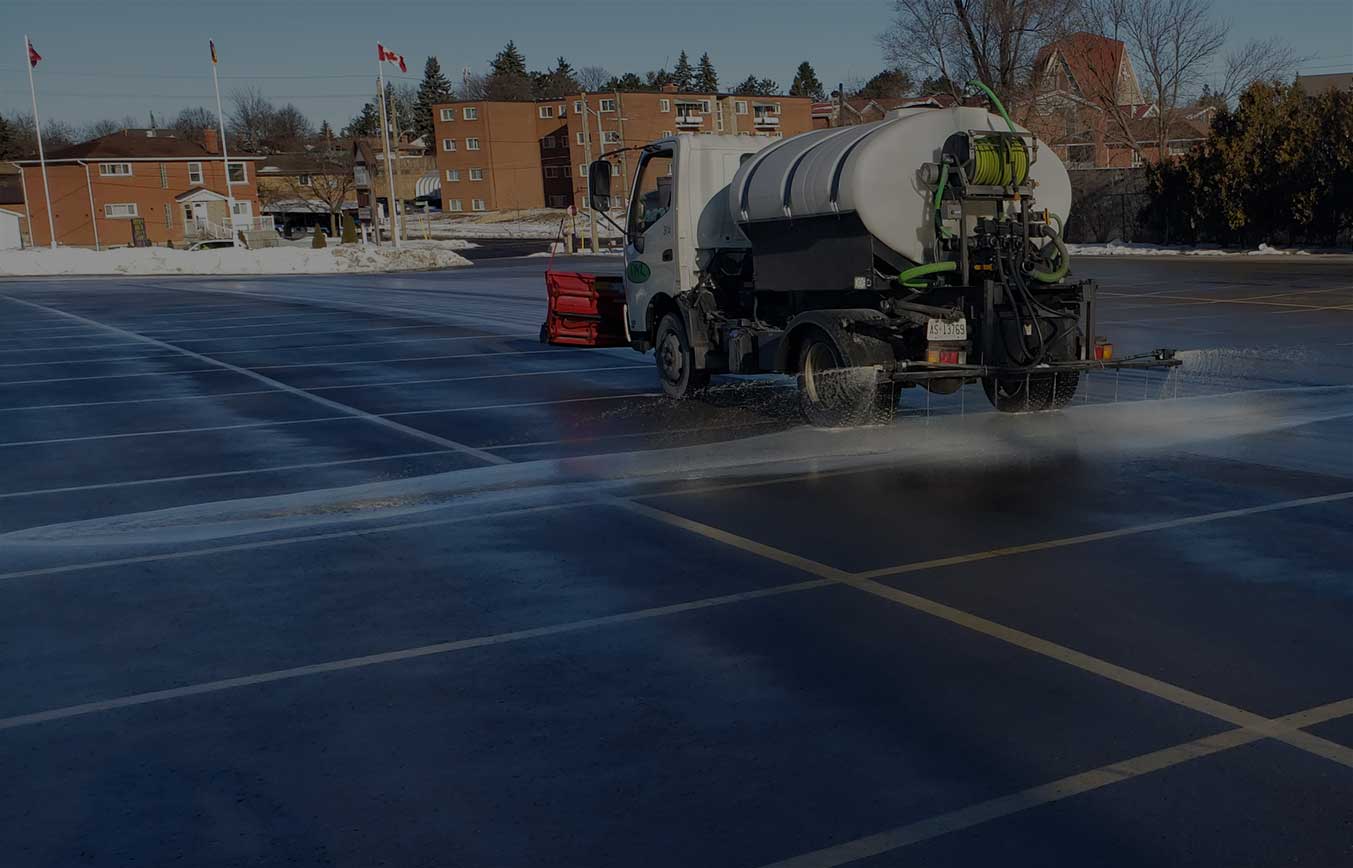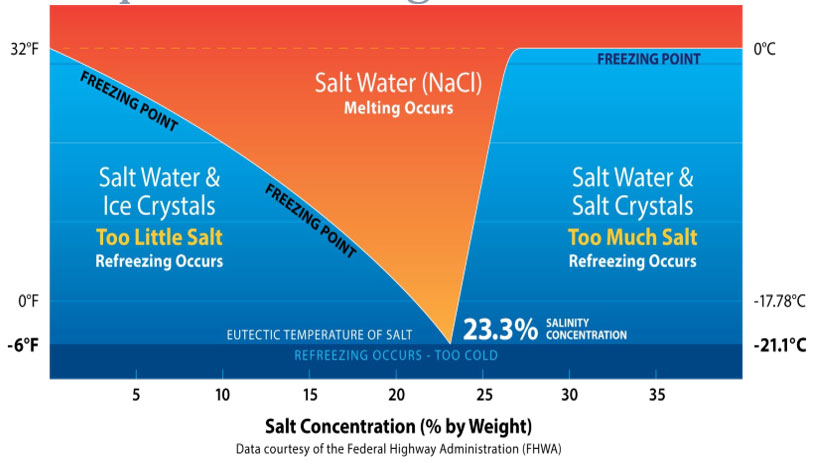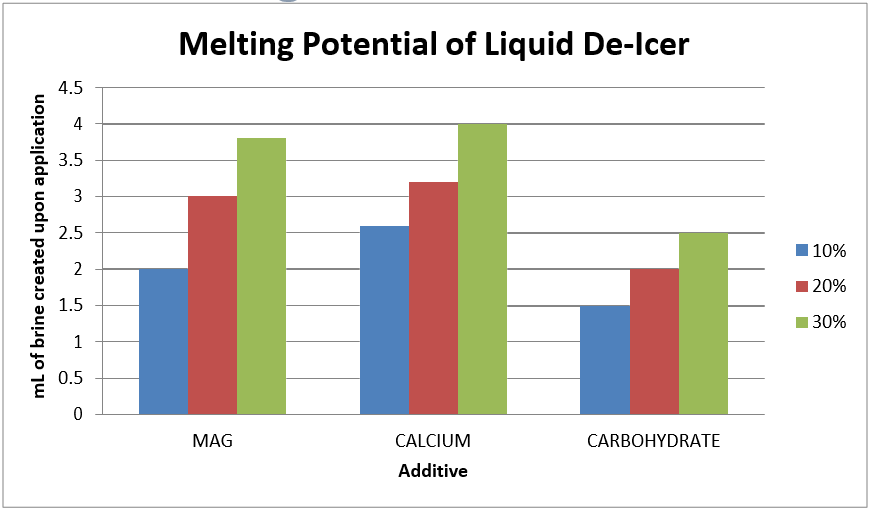Liquids Implementation
Benefits of starting a liquids operation
-
Enhanced revenue
-
Less salt used
-
Logistical efficiency
-
-
Environmental responsibility – chloride reduction (75%)
-
Cleaner sites in the winter (clients love it)
-
Reduction of interior janitorial services required
-
Reduced vegetation damage
-
Infrastructure on properties have a longer life span
-
-
Safer surface conditions throughout all winter conditions
-
Freezing rain included – with experience this is no longer an emergency
-
Using liquids in the winter to mitigate ice and snow accumulation requires many of the same logistics as traditional dry salt application
-
-
-
Monitoring weather conditions
-
Mechanically plowing when accumulations are present
-
Transporting de-icing material to multiple locations
-
Ensuring correct volume of de-icer is applied to ensure safe surface conditions
-
-
Both liquids and solid de-icers are subject to all these procedures. Liquids can disrupt the timing and order of these operations; it does not remove any one of these but when each individual item is preformed can be adjusted.
Liquid De-Icing Science Foundations
There is some basic scientific knowledge that is important to know when using liquids. These items will aid in the formulation of a liquids approach. How much liquid is required to ensure safe surface conditions in the winter? By understanding the relationship between the melting potential of dry salt and its liquids equivalent, planning can occur on the logistics of a liquids de-icing approach.
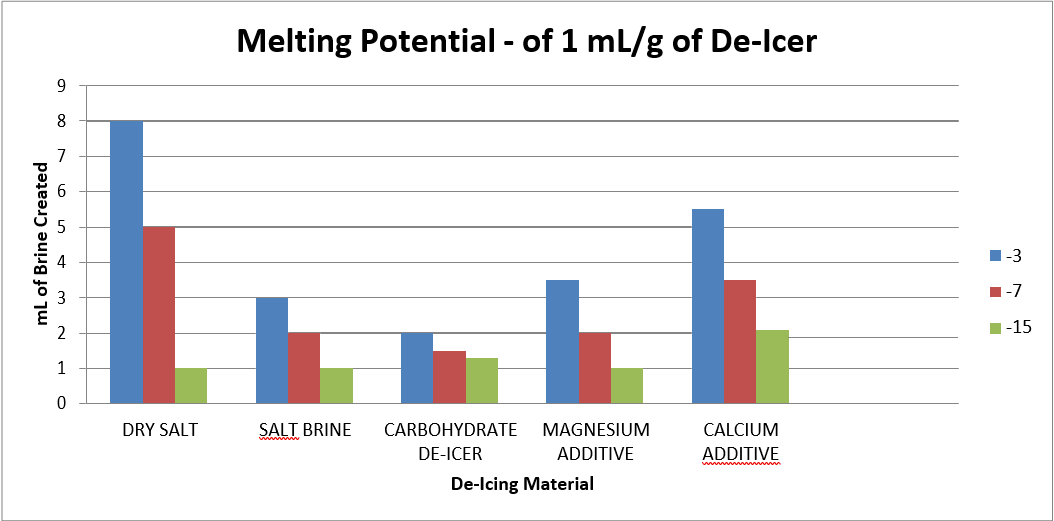
This melting potential is used as a guideline when deciding on a liquid application rate. 2L of brine for every 1kg of salt will provide for nearly the same melting potential as traditional dry salt application potential when dealing with temperatures above -7 but 1L per 1kg of application rate will provide effective control of surfaces in the winter. Additives enhance the speed- melting potential – of salt brine. The additive percentage is an important and necessary element of liquid de-icing, without adequate blending liquid de-icing will lag behind traditional methods in both speed and effectiveness. All specs provided came from the Minnesota Department of Transportation Research Services.
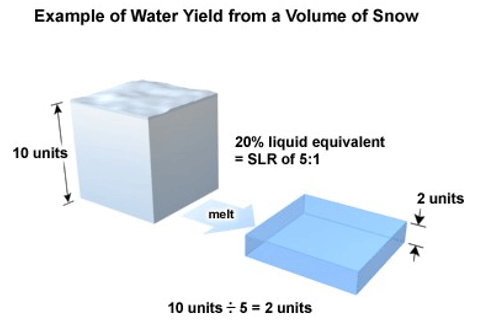
Snow to Liquid Calculations
Liquid equivalent of snow is an important piece of information to measure in a liquids approach. How much water does the incoming snow have in it? The amount of water to be acted upon and timing of snow event formulates the logistical decisions of a liquid application. This information is imperative in additive percentage and application rate decisions. Timing of the snows arrival is also a consideration; is there time to plow the snow once it has accumulated or must it be melted to maintain access to the property throughout the event.

What is Salt Brine and how does it become a replacement for traditional Methods
Salt brine for liquid de-icing is a solution of 23% salt in water. At this concentration the lowest freeze point is achieved. Any variance of the concentration either higher or lower will result in a higher freeze point. Dry salt must change state to a liquid in order to affect snow and ice. The production of salt brine simply is a measured amount of salt is added to water until the desired concentration is achieved. In a liquids operation the change of state is done in advance of application. Which results in no time or environmental conditions required before the product can get to the important work of melting the accumulated snow and ice. Salt brine removes one step of the de-icing process. In simple terms, salt brine is ready to melt immediately upon application to the surface.
Salt brine is the base that is used to blend additives into when creating de- icing liquids that can handle all winter conditions. Salt brine does not have the capacity to do this alone. The blending of additives into the salt brine will enhance the speed and functionality of the de-icer. Without additives salt brine is simply unable to replace traditional dry salt application. Salt brine is blend anywhere from 5 – 30% with additive. The use of liquids in the winter will reduce salt usage by 75% while continuing to provide the safe winter conditions that we have become accustomed to. Salt brine is an effective means to reduce sodium use during the winter months and blending of additives with the salt brine, creates a de-icer effectively performing in any temperature range or winter precipitation event.
Blending of Liquid De-icers
-
How to blend a tank of salt brine with additive
-
Determine the size of the tank
-
Decide on the desired blend percentage
-
When referred to as a 10% blend this means that there is 10% additive and 90% salt brine
-
-
Calculate the amount of additive required for the volume of the tank
-
It is important to fill tanks from the bottom to decrease the presence of foam
-
-
Pump in enough salt brine to cover the inlet port on the tank
-
Then pump in the calculated additive amount
-
Finish filling the tank to its capacity
-
Now the tank is ready for application
-
Deciding on what blend to use can seem difficult at the beginning of the liquids implementation as the ability to customize the melting potential of the de-icer is a deviation from the traditional dry salt application skill set. Traditionally there has been little augmentation available in de-icers (white salt, treated salt, or ice melter) and only a changing of application rates to accommodate differing temperatures and winter conditions. Liquid blending provides the ability to customize the melting potential of de-icer for the situation.
Monitoring weather conditions
Keeping a close eye on the weather details for any individual property is a process of contrasting forecast models against current conditions. What weather details are important for snow and ice management?
-
Temperature – ground and air
-
Air temp is traditionally important and easy to find
-
Ground temp is very important for liquids and you will have to look for a service to provide this– these types of details are available from DTN Weather Service
-
-
Dew point monitoring – black ice and frost
-
These two environmental events are naturally occurring ice formation situations that require diligent monitoring of forecasts
-
Traditional approaches are to react to these events when they occur
-
Liquids removes these as a threat with maintenance of a de-icer presence on the surface
-
-
Precipitation
-
What type of precipitation, how much and when? These are the foundations of snow and ice management decisions. This is where forecast models and radar images play a large roll in operational decisions when it comes to reacting to the incoming precipitation with the appropriate method of
-
Traditionally preparation included waiting for snow or ice accumulation before initiating service and in some extreme situations even the pre application of dry material – this process can be quite expensive if the forecast modelling does not equate with actual Dry de-icer does not hold well and wait well on the surface as it is dependent on moisture to activate; things such as traffic and wind can move the de- icer from the location that it has been applied.
-
A Liquids approach would see pre application of de-icer at a rate that is in keeping with the predicted precipitation form and amount. The pre application’s function is to create a layer of brine between the precipitation and the surface. This provides for the maintaining of safe conditions throughout a snow event by breaking the bond between the surface and the snow. Shoes and tires will be travelling on a slushy surface which provides for a firmer surface contact. This also makes it easier for removal of the accumulated snow, freezing rain, ice pellets and sleet down to the surface, with less residual ice and snow having to be removed with de-icer. In the event that the conditions forecast do not transpire the de-icer will have bonded to the surface and will not track away with traffic or wind. Liquid pre application stays where it is applied until precipitation arrives to use it up as the activation process – changing of state from solid to liquid – has occurred in advance of
-
Liquids application both pre and post weather events require specific techniques to ensure even application on all surfaces. Since liquids do not migrate after application all surfaces must be treated to ensure de-icing is complete.
-
Liquids application is dependent upon rate and additive percentage. These two items must be calculated in order to achieve success. This ability to modify the de-icer is a divergence from the traditional model and time must be spent understanding the functions both play in the de-icing process
-
-
-
How much snow accumulation can the de-icer blend melt and keep from bonding to the surface before extra service is required?
-
What is the “best” time to provide extra service?
Mechanical Snow Removal
Mechanical Snow Removal is the act of removing accumulated snow and ice from a surface by physical means. This includes shoveling, plowing, and blowing snow from one surface to another. This method of snow removal relies on the interaction of the scraping tools’ ability to follow the contour of the surface. Once this operation has been completed the surface can be acted upon with de-icers to remove the remaining snow and ice left behind by the mechanical methods.
This mechanical removal of snow is similar in both a traditional and liquids approach. The difference a well- developed liquids program will provide is: significantly reduced snow and ice remaining on the surface after plowing. A pre application ensures that snow and ice do not bond to the surface in a hard pack or ice layer if adequately maintained throughout the event. With a reduced volume of snow and ice to melt after snow clearing operations less de-icer is require to regain the surface.
Liquids notes on snow clearing
-
If the surface becomes slippery upon initially clearing snow and dissipates within 20 to 30 min. of clearing not enough de-icer was applied in advance of the snow event. This situation can occur in temps below -7.
Liquids Infrastructure and Logistics
The delivery of liquid de-icer from the holding tank to each individual location is similar to traditional methods. De-icer is mainly carried in tanks on the back of trucks and tractors. Yet currently there are no commercial depot locations to fill sprayers from. In order to use liquids to control snow and ice, a tank infrastructure is required. Sizing, location, and plumbing of the tank array is important to the efficiency of a liquid delivery system.
-
Tank array
-
How to get liquid into and out of the tank?
-
Where should the tank(s) be located?
-
What is the future capacity of our system?
-
Tank capacity
-
How much is volume needs to be ready to go for a storm?
-
How quickly can the tanks be replenished?
-
-
Pumps need to be used to move the de-icer
-
Are the pumps on the individual sprayer sufficient?
-
Does there need to be stand-alone pumps to load tanks and sprayers?
-
-
Salt brine must be either made in house or delivered by supplier
-
How to make brine?
-
How much brine is required?
-
How much time is required to make brine?
-
-
Additives need to be received from suppliers and blended with salt brine in order to be ready when winter conditions require their
-
What additive is best?
-
What blend is “right”?
-
Is each sprayer individually blended or should there be pre blended mixes?
-
-
-
Remote tanks? – should there be tanks off site to increase efficiency?
-
How are they kept full?
-
When do they get used?
-
Are they pre blended?
-
-
What size of sprayers?
-
How much area can a sprayer cover?
-
Having a well thought out system of flow is important in order to achieve a successful liquids operation.
The loading of the de-icer onto the mobile unit is quite a bit different than traditional dry salt. Liquid de-icer needs to be pumped from storage tanks, and then blended with additive in order to be ready for application. Hoses, valves, pumps, and delivery vehicles all need to work together to enable a liquids operation to be effective.
How to spray de-icer
In many respects this is the biggest deviation from traditional snow and ice removal. The act of using a sprayer in the winter is unlike any of the snow and ice skill set that is currently taught. Handling a liquid unit in a snow event can appear complicated. Some of the principles of sprayer application equipment:
-
Product is heavy and requires careful driving techniques to ensure safe transportation from one location to the
-
Liquids are an active load – the product responds with movement from the road and driver input – verses a static nature of load of salt
-
-
A pump is required to move the product to a spray bar from the holding tank
-
Ensure there are no leaks in the system before departure
-
Inspect spray bar for proper operations of all nozzles
-
Do not run the pump dry!
-
Operation of a pump without liquid in it quickly damages the seal and renders the unit in-operative.
-
-
Control Units- understanding the principles in advance of operation
-
Rate control system
-
Automatic flow control based on speed
-
The telematics involved in this system can be expensive
-
Is this the right system for your operations
-
Open smooth driving area rate control can be effective
-
For small areas with many stops and starts this system does not provide adequate response, or coverage so manual mode is required
-
-
These systems provide set flow rate throughout a driving speed range
-
If you slow down or speed up the flow remains at the “same” volume per area
-
-
Pressure based spray systems
-
Manual flow control
-
Pressure is maintained through gauge and manual switch to adjust
-
-
Simple plumbing of sprayer – less expensive upfront costs
-
-
Application of product onsite
-
All areas on site that need to have snow and ice controlled must be
-
Liquids do not migrate from where they are applied
-
Corners and in between cars must be sprayed
-
-
Understand the capacities of the sprayer
-
How quickly can it get on rate?
-
How far can it spray from the truck?
-
What speed can I apply it at?
-
How quickly does the boom valve react?
-
-
Plan your route through a property to limit overlapping too much
-
What is the right rate
-
How to know how much to apply?
-
How quickly does the de-icer melt the snow?
-
-
-
Is it time to get your feet wet?
Learn the principals and processes of Liquid De-Icing.
Full day event
$600.00 / Seat On Site at :
Liquids Revolution
967672 Oxford-Waterloo Rd
New Dundee, ON
Find out what you have been missing and how to be successful!


